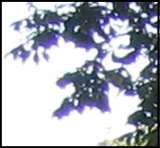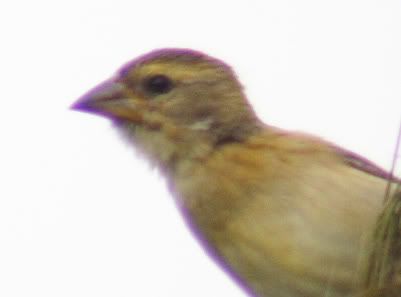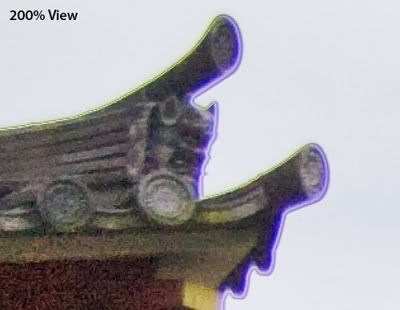Виденье ауры
Вот чего я терпеть не могу - так это безграмотной хуйни. Что от официоза, что от альтернативщиков. "Техника виденья ауры" попалась мне намедни не в первый раз, и я таки скажу, что это такое.
Такое явление, как некая радужная оболочка вокруг предметов, действительно существует, и действительно можно научиться её видеть. Отрицание этого - безграмотность. Но это НЕ аура, это НЕ электромагнитное поле. Электромагнитное поле находится в невидимом человеком спектре. Это - хромати́ческие аберра́ции, в Вики достаточно подробная статья. http://ru.wikipedia.org/wiki/%D0%A5%D1%80%D0%BE%D0%BC%D0%B0%D1%82%D0%B8%D1%87%D0%B5%D1%81%D0%BA%D0%B8%D0%B5_%D0%B0%D0%B1%D0%B5%D1%80%D1%80%D0%B0%D1%86%D0%B8%D0%B8
http://en.wikipedia.org/wiki/Chromatic_aberration
Эти аберра́ции практически все видели на фотографиях, особенно сделанных в пасмурный день, они хорошо видны вокруг тонких веток или проводов в виде фиолетовой сетки. Это то, что можно видеть на фотографиях и что зависит от качества оптики.
Есть другой вариант - поставить объект на однотонный фон, приглушить свет и смотреть расфокусированным взглядом. Тогда аберра́ции будут белыми, а не фиолетовыми. Это именно то, что можно видеть глазом.
Под катом картинки и сама техника "виденья ауры".



Источники картинок:
http://travel.paintedstork.com/blog/2009/06/thursday-travel-photography-understanding-what-is-a-technically-bad-image.html
http://www.nightskyinfo.com/binoculars-tests/
http://www.webdesign.org/photoshop/photo-editing/photoshop-cs3-underexposure-s-o-s.15633.html
Способ 1: Посмотрите на область в пределах 1-2 дюймов (2,5-5 см) от головы человека (фоновое освещение должны быть немного ярче для этого). Часто энергия появится в виде короны или ореола, который не имеет цвета, но слегка мерцает, как марево над дорогой в жаркий летний день. Не забывайте использовать расфокусированный взгляд и неяркий фон. Попрактикуйте это с открытыми глазами, и если вы не видите разницу, попробуйте с закрытыми глазами. С практикой, большинство людей начинают воспринимают это довольно быстро (примерно за пять-десять минут).
Следующий шаг - смотреть дальше от головы, сознательно и терпеливо, расфокусированным взглядом, и часто вы начнёте также воспринимать цвета.
Способ 2: Практикуйте это перед зеркалом, от трёх до пяти футов (1-1,5 м) от стекла. Убавьте освещение, но не делайте его слишком тёмным. Организуйте мягкий фон позади вас (вы можете повесить плакат обычной бумаги, как импровизированный фон). Посмотрите на своё отражение в зеркале, расфокусируя ваш взгляд, и наблюдайте за районом сразу над вашей головой. Моргайте как можно реже и практикуйте это внимание в течение 5-15 минут за один раз. Обычно в течение двух недель вы начнёте видеть цвета.
Способ 3: Если вы носите очки, снимите их. Посмотрите вокруг комнаты поверхностно, не фокусируя взгляд. В идеале, освещение должны приглушённым (довольно тёмным), а фон должен быть белым или, по крайней мере, очень простым.
Посмотрите на миллиарды крошечных "точек" в воздухе между вами и другим объектом, другим человеком в комнате (на расстоянии от 8 до 10 метров), например, или лампой или столом. "Точки", которые вы видите, - частицы Ци и строительных блоков Вселенной.
Возможно, на начальном этапе вам придётся закрыть глаза, чтобы увидеть точки. Как только вы начнёте воспринимать их с закрытыми глазами, позднее вы можете "видеть" их с открытыми глазами. Я называю это "видеть Ци в неуплотнённом состоянии", т.е. не в виде стола, человека или какой-либо твёрдой структуры.
Последний способ - это не хроматические аберра́ции, но, разумеется, и не виденье ауры. Это работа нервной системы. Бывают ещё "плавающие" объекты - ткани, плавающие в жидкости глаза. И ещё на сетчатку могут падать тени от сосудов.
http://en.wikipedia.org/wiki/Blue_field_entoptic_phenomenon
The blue field entoptic phenomenon or Scheerer's phenomenon is the appearance of tiny bright dots moving quickly along squiggly lines in the visual field, especially when looking into bright blue light (such as the sky).[1] This is a normal effect that can be perceived by almost everybody. The dots are white blood cells in the capillaries in front of the retina of the eye, near the macula.[2]
This ophtalmogram shows the blood vessels that lie in front of the retina. Their shadow is the cause of the blue field entoptic phenomenon.
Blue light (optimal wavelength: 430 nm) is well absorbed by the red blood cells that fill the capillaries. The eye and brain "edit out" the shadow lines of the capillaries, partially by dark adaptation of the photoreceptors lying beneath the capillaries. The white blood cells, which are much rarer than the red ones and do not absorb blue light well, create gaps in the blood column, and these gaps appear as bright dots. They won't appear at the very center of the visual field, because there are no blood vessels in the fovea. The effect is rather weak, and many people don't notice it at all. It is strongest when looking at a smooth blue surface.
In a technique known as blue field entoptoscopy, the effect is used to measure the blood flow in the retinal capillaries. The patient is alternatingly shown blue light and a computer generated picture of moving dots; by adjusting the speed and density of these dots, the patient tries to match the computer generated picture as well as possible to the perceived entoptic dots. This then allows calculation of the blood flow in the capillaries. This test is important in diseases such as diabetes which can cause retinopathy.
Scheerer's phenomenon should not be confused with "floaters" (muscae volitantes). Scheerer's phenomenon is distinguished by the appearance of multiple, identical-looking bright dots that move around rapidly in random directions. Floaters are variable in appearance; although they sometimes are dots, they often have the appearance of threads or shreds of crumpled cellophane. Floaters remain almost stationary or drift slowly and do not follow well-defined paths. They are due to debris floating in the vitreous humor of the eye. There are also several phosphenes that need to be distinguished from Scheerer's phenomenon.
http://en.wikipedia.org/wiki/Floater
Floaters are deposits of various size, shape, consistency, refractive index, and motility within the eye's vitreous humour, which is normally transparent.[1][2] They may be of embryonic origin or acquired due to degenerative changes of the vitreous humour or retina.[1] The perception of floaters is known as myodesopsia,[3] or less commonly as myiodeopsia, myiodesopsia, or myodeopsia.[1] Floaters are visible because of the shadows they cast on the retina[4] or their refraction of the light that passes through them, and can appear alone or together with several others in one's field of vision. They may appear as spots, threads, or fragments of cobwebs, which float slowly before the observer's eyes.[2] Since these objects exist within the eye itself, they are not optical illusions but are entoptic phenomena.
One specific type of floater is either called Muscae volitantes (from the Latin, meaning 'flying flies'), or mouches volantes (from the French), and consist of small spots. These are present in most people's eyes and are attributed to minute remnants of embryonic structures in the vitreous humour.
Такое явление, как некая радужная оболочка вокруг предметов, действительно существует, и действительно можно научиться её видеть. Отрицание этого - безграмотность. Но это НЕ аура, это НЕ электромагнитное поле. Электромагнитное поле находится в невидимом человеком спектре. Это - хромати́ческие аберра́ции, в Вики достаточно подробная статья. http://ru.wikipedia.org/wiki/%D0%A5%D1%80%D0%BE%D0%BC%D0%B0%D1%82%D0%B8%D1%87%D0%B5%D1%81%D0%BA%D0%B8%D0%B5_%D0%B0%D0%B1%D0%B5%D1%80%D1%80%D0%B0%D1%86%D0%B8%D0%B8
http://en.wikipedia.org/wiki/Chromatic_aberration
Эти аберра́ции практически все видели на фотографиях, особенно сделанных в пасмурный день, они хорошо видны вокруг тонких веток или проводов в виде фиолетовой сетки. Это то, что можно видеть на фотографиях и что зависит от качества оптики.
Есть другой вариант - поставить объект на однотонный фон, приглушить свет и смотреть расфокусированным взглядом. Тогда аберра́ции будут белыми, а не фиолетовыми. Это именно то, что можно видеть глазом.
Под катом картинки и сама техника "виденья ауры".



Источники картинок:
http://travel.paintedstork.com/blog/2009/06/thursday-travel-photography-understanding-what-is-a-technically-bad-image.html
http://www.nightskyinfo.com/binoculars-tests/
http://www.webdesign.org/photoshop/photo-editing/photoshop-cs3-underexposure-s-o-s.15633.html
Способ 1: Посмотрите на область в пределах 1-2 дюймов (2,5-5 см) от головы человека (фоновое освещение должны быть немного ярче для этого). Часто энергия появится в виде короны или ореола, который не имеет цвета, но слегка мерцает, как марево над дорогой в жаркий летний день. Не забывайте использовать расфокусированный взгляд и неяркий фон. Попрактикуйте это с открытыми глазами, и если вы не видите разницу, попробуйте с закрытыми глазами. С практикой, большинство людей начинают воспринимают это довольно быстро (примерно за пять-десять минут).
Следующий шаг - смотреть дальше от головы, сознательно и терпеливо, расфокусированным взглядом, и часто вы начнёте также воспринимать цвета.
Способ 2: Практикуйте это перед зеркалом, от трёх до пяти футов (1-1,5 м) от стекла. Убавьте освещение, но не делайте его слишком тёмным. Организуйте мягкий фон позади вас (вы можете повесить плакат обычной бумаги, как импровизированный фон). Посмотрите на своё отражение в зеркале, расфокусируя ваш взгляд, и наблюдайте за районом сразу над вашей головой. Моргайте как можно реже и практикуйте это внимание в течение 5-15 минут за один раз. Обычно в течение двух недель вы начнёте видеть цвета.
Способ 3: Если вы носите очки, снимите их. Посмотрите вокруг комнаты поверхностно, не фокусируя взгляд. В идеале, освещение должны приглушённым (довольно тёмным), а фон должен быть белым или, по крайней мере, очень простым.
Посмотрите на миллиарды крошечных "точек" в воздухе между вами и другим объектом, другим человеком в комнате (на расстоянии от 8 до 10 метров), например, или лампой или столом. "Точки", которые вы видите, - частицы Ци и строительных блоков Вселенной.
Возможно, на начальном этапе вам придётся закрыть глаза, чтобы увидеть точки. Как только вы начнёте воспринимать их с закрытыми глазами, позднее вы можете "видеть" их с открытыми глазами. Я называю это "видеть Ци в неуплотнённом состоянии", т.е. не в виде стола, человека или какой-либо твёрдой структуры.
Последний способ - это не хроматические аберра́ции, но, разумеется, и не виденье ауры. Это работа нервной системы. Бывают ещё "плавающие" объекты - ткани, плавающие в жидкости глаза. И ещё на сетчатку могут падать тени от сосудов.
http://en.wikipedia.org/wiki/Blue_field_entoptic_phenomenon
The blue field entoptic phenomenon or Scheerer's phenomenon is the appearance of tiny bright dots moving quickly along squiggly lines in the visual field, especially when looking into bright blue light (such as the sky).[1] This is a normal effect that can be perceived by almost everybody. The dots are white blood cells in the capillaries in front of the retina of the eye, near the macula.[2]
This ophtalmogram shows the blood vessels that lie in front of the retina. Their shadow is the cause of the blue field entoptic phenomenon.
Blue light (optimal wavelength: 430 nm) is well absorbed by the red blood cells that fill the capillaries. The eye and brain "edit out" the shadow lines of the capillaries, partially by dark adaptation of the photoreceptors lying beneath the capillaries. The white blood cells, which are much rarer than the red ones and do not absorb blue light well, create gaps in the blood column, and these gaps appear as bright dots. They won't appear at the very center of the visual field, because there are no blood vessels in the fovea. The effect is rather weak, and many people don't notice it at all. It is strongest when looking at a smooth blue surface.
In a technique known as blue field entoptoscopy, the effect is used to measure the blood flow in the retinal capillaries. The patient is alternatingly shown blue light and a computer generated picture of moving dots; by adjusting the speed and density of these dots, the patient tries to match the computer generated picture as well as possible to the perceived entoptic dots. This then allows calculation of the blood flow in the capillaries. This test is important in diseases such as diabetes which can cause retinopathy.
Scheerer's phenomenon should not be confused with "floaters" (muscae volitantes). Scheerer's phenomenon is distinguished by the appearance of multiple, identical-looking bright dots that move around rapidly in random directions. Floaters are variable in appearance; although they sometimes are dots, they often have the appearance of threads or shreds of crumpled cellophane. Floaters remain almost stationary or drift slowly and do not follow well-defined paths. They are due to debris floating in the vitreous humor of the eye. There are also several phosphenes that need to be distinguished from Scheerer's phenomenon.
http://en.wikipedia.org/wiki/Floater
Floaters are deposits of various size, shape, consistency, refractive index, and motility within the eye's vitreous humour, which is normally transparent.[1][2] They may be of embryonic origin or acquired due to degenerative changes of the vitreous humour or retina.[1] The perception of floaters is known as myodesopsia,[3] or less commonly as myiodeopsia, myiodesopsia, or myodeopsia.[1] Floaters are visible because of the shadows they cast on the retina[4] or their refraction of the light that passes through them, and can appear alone or together with several others in one's field of vision. They may appear as spots, threads, or fragments of cobwebs, which float slowly before the observer's eyes.[2] Since these objects exist within the eye itself, they are not optical illusions but are entoptic phenomena.
One specific type of floater is either called Muscae volitantes (from the Latin, meaning 'flying flies'), or mouches volantes (from the French), and consist of small spots. These are present in most people's eyes and are attributed to minute remnants of embryonic structures in the vitreous humour.